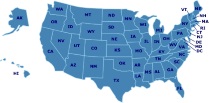Libraries
National Libraries
American Memory
Library of Congress
America's Story from America's Library
Libraries & Homeschoolers: Working Together
How to Homeschool Using Only the Library
The library is a wonderful resource for any homeschool parent. The resources found there help to enrich the curriculum or you can even use the library for all of your homeschooling material. These tips will help you get the most out of your local library.
Homeschoolers and Public Libraries: A Synergistic Relationship
Homeschoolers are commonly heavy users of their local libraries. Statistics show that more than 78 percent of home educators use the public library as their primary resource for curriculum supported materials. So, how do libraries become educational “hubs” for homeschoolers? They develop programs and services to support this burgeoning population by offering programs, digital information, and events that support homeschooling families. The energy and vibrant curiosity that home-educated children have, and the commitment and support their parents contribute, make libraries a better place for all.
Homeschooling and Libraries: New Solutions and Opportunities
Homeschools are alwsy looking for alternative ways of schooling that do not necessarily reflect what a typical classroom looks like. Since homeschooling is so diverse across families, information institutions, including public, academic, school, and special libraries may find it challenging to meet all their needs and desires. This collection of essays offers approaches and strategies from library professionals and veteran homeschoolers on how to best serve the needs and experiences of homeschooled youth. This book includes information on special needs homeschooling, gifted students, and African American students as well.
Homeschoolers and the Public Library
Public libraries are invaluable tools for DIY educators and home education. Home-based educators utilize various curriculum sources to assist in teaching. The National Center for Educational Statistics published a survey from 2012, in which 70% of homeschooled parents cite the public library as their most valued resource. This article, written for the American Library Association, details how librarians can meet the needs and work in partnership with homeschooling families.
Helping Homeschoolers in the Library
This practical guidebook seeks to bridge the gap between librarians and homeschoolers in these two ways: who are homeschoolers and how can I help them practically? Part 1 addresses the history and background of homeschooling as well as the needs and viewpoints of various homeschooling groups. Part 2 deals specifically with building programs and services for the homeschooling population. By moving past stereotypes and understanding what resources are available, librarians can be important allies to this diverse group of patrons. Children's and YA librarians, library directors, support staff working with youth in public libraries and educators will find the information and tools they need to develop policies, programs, and services to support homeschoolers in their communities.
A Home Away from Home: Libraries & Homeschoolers
Homeschool Library Connection
Homeschooling: Exploring the Potential of Public Library Service for Homeschooled Students
As the number of homeschooled students rises in this country, needs for resources, instruction and support also has risen. The homeschooled students, while not participating in the school classrooms and by extension the school or public libraries, have needs that should be satisfied by library services. These include access to materials and technology, information literacy skills instruction, reading and writing support, curriculum materials and methods, reference services, as well as areas to “make and take”, facilities for quiet study or to meet with mentors or tutors. In addition, homeschooled students need the kind of library skills instruction that all students in traditional school libraries receive. The purpose of this study is to identify the strengths and weaknesses of library support to homeschooled students and to make recommendations based upon analysis.
Serving Homeschooled Teens and Their Parents (Libraries Unlimited Professional Guides for Young Adult Librarians Series)
This guide for librarians addresses the needs of homeschooled teens and how a library can meet those needs. Includes ideas like developing a homeschool resource and book collection to creating special homeschool programs. While this book was written for library staff, it is also an insightful guide into how homeschoolers and libraries can work together.
Four Reasons Why Libraries are Homeschooling Hotspots
There are four reasons why libraries should be indispensable for homeschooling families. They offer resources and materials for homeschool students, individualized help and tutoring, activities and events for homeschoolers, and opportunities for parents.
Featured Resources
As an Amazon Associate, we earn from qualifying purchases. We get commissions for purchases made through links on this site.




